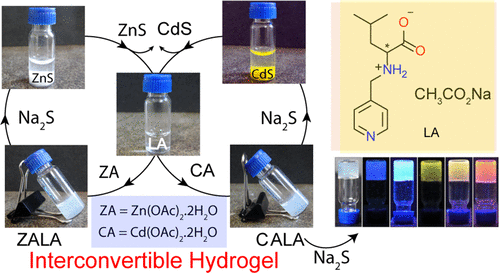当前位置:
X-MOL 学术
›
Chem. Mater.
›
论文详情
Our official English website, www.x-mol.net, welcomes your
feedback! (Note: you will need to create a separate account there.)
Multistimuli-Responsive Interconvertible Low-Molecular Weight Metallohydrogels and the in Situ Entrapment of CdS Quantum Dots Therein
Chemistry of Materials ( IF 7.2 ) Pub Date : 2018-06-20 00:00:00 , DOI: 10.1021/acs.chemmater.8b01698 Saibal Bera , Amit Chakraborty , Suvendu Karak , Arjun Halder , Soumyajyoti Chatterjee , Subhadeep Saha , Rahul Banerjee 1
Chemistry of Materials ( IF 7.2 ) Pub Date : 2018-06-20 00:00:00 , DOI: 10.1021/acs.chemmater.8b01698 Saibal Bera , Amit Chakraborty , Suvendu Karak , Arjun Halder , Soumyajyoti Chatterjee , Subhadeep Saha , Rahul Banerjee 1
Affiliation

|
Two low molecular weight metallohydrogels (ZALA and CALA) have been synthesized from an amino-acid-based ligand precursor (LA) and two different metal salts [zinc acetate dihydrate (ZA) and cadmium acetate dihydrate (CA), respectively. These two hydrogels show a unique chemically stimulated interconversion to each other via a reversible gel–sol–gel pathway. This programmable gel–sol reversible system satisfies logic operations of a basic Boolean logic (INHIBIT) gate. Also, these hydrogels can be degraded into different MOF phases at room temperature spontaneously or in the presence of chloride and bromide salts (NaCl and NaBr.). CdS quantum dots can be grown inside the CALA gel matrix ([email protected]) in the presence of small amount of Na2S. This CdS doped gel exhibits time dependent tunable emission (white to yellow to orange) as a consequence of a slow agglomeration process of the entrapped quantum dots inside the gel matrix. This luminescence property also reflects the corresponding gel derived MOFs (obtained either by self-degradation of [email protected] or via anion induction) as well. This, to the best of our knowledge, is probably the simplest way to make a CdS quantum dot based composite material where CdS is entrapped within the gel and the gel-derived MOF matrix.
中文翻译:

多种刺激响应的可互转换的低分子量金属水凝胶及其中的CdS量子点的原位俘获
两种低分子量金属水凝胶(ZALA和CALA)已从基于氨基酸的配体前体(LA)和两种不同的金属盐[分别为醋酸锌二水合物(ZA)和醋酸镉二水合物(CA)合成。这两种水凝胶通过可逆的凝胶-溶胶-凝胶途径表现出独特的化学刺激相互转化。这个可编程的凝胶-溶胶可逆系统满足基本布尔逻辑(INHIBIT)门的逻辑运算。同样,这些水凝胶可在室温下自发或在氯化物和溴化物盐(NaCl和NaBr。)存在下自发降解为不同的MOF相。CdS量子点可以在少量Na 2存在的情况下在CALA凝胶基质([受电子邮件保护])中生长S.这种CdS掺杂的凝胶表现出时间依赖性的可调发射(白色至黄色至橙色),这是凝胶基质内部截留的量子点的缓慢聚集过程的结果。这种发光性质也反映了相应的凝胶衍生的MOF(通过[email protected]的自降解或通过阴离子诱导获得)。据我们所知,这可能是制造基于CdS量子点的复合材料的最简单方法,其中CdS截留在凝胶和凝胶衍生的MOF基质中。
更新日期:2018-06-20
中文翻译:

多种刺激响应的可互转换的低分子量金属水凝胶及其中的CdS量子点的原位俘获
两种低分子量金属水凝胶(ZALA和CALA)已从基于氨基酸的配体前体(LA)和两种不同的金属盐[分别为醋酸锌二水合物(ZA)和醋酸镉二水合物(CA)合成。这两种水凝胶通过可逆的凝胶-溶胶-凝胶途径表现出独特的化学刺激相互转化。这个可编程的凝胶-溶胶可逆系统满足基本布尔逻辑(INHIBIT)门的逻辑运算。同样,这些水凝胶可在室温下自发或在氯化物和溴化物盐(NaCl和NaBr。)存在下自发降解为不同的MOF相。CdS量子点可以在少量Na 2存在的情况下在CALA凝胶基质([受电子邮件保护])中生长S.这种CdS掺杂的凝胶表现出时间依赖性的可调发射(白色至黄色至橙色),这是凝胶基质内部截留的量子点的缓慢聚集过程的结果。这种发光性质也反映了相应的凝胶衍生的MOF(通过[email protected]的自降解或通过阴离子诱导获得)。据我们所知,这可能是制造基于CdS量子点的复合材料的最简单方法,其中CdS截留在凝胶和凝胶衍生的MOF基质中。











































 京公网安备 11010802027423号
京公网安备 11010802027423号